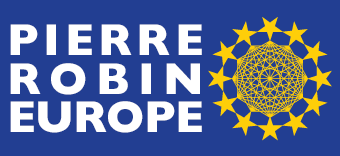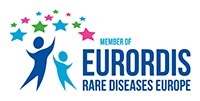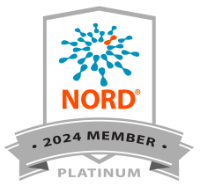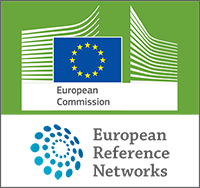A parent’s view on the care of their baby with Pierre Robin Sequence
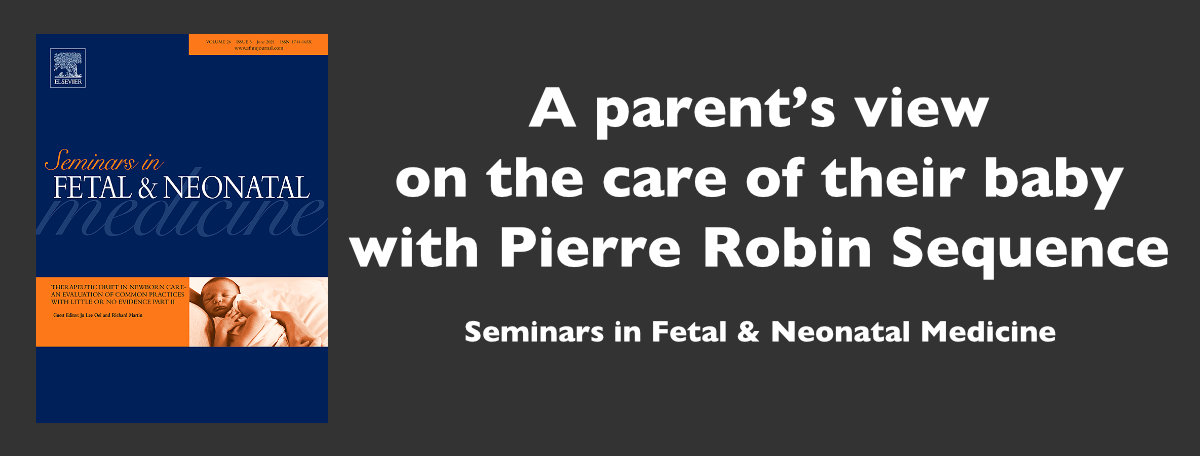
A patient’s perspective on rare disease care. From “Seminars in Fetal & Neonatal Medicine”.
Feedback:
“Thanks, Philippe – this is tremendous and it emphasises the need or should I say absolute imperative that we obtain and heed the patient / parent perspective in the approach to rare diseases. This certainly provides aspects that we do not read about in the textbooks.”
– Prof. Dr. Peter A. Mossey
Professor and Personal Chair of Craniofacial Development & Dentofacial Orthopaeds, the University of Dundee; Associate Dean for Research; Director of WHO Collaborating Centre for Craniofacial Anomalies and Technology Transfer
A parent’s view on the care of their baby with Robin sequence
Abstract
A Robin sequence parent presents the view that Robin sequence healthcare providers are engaging in practices which may be outdated, excessively invasive, and unnecessarily detrimental to quality of life, and proposes possible areas of research to improve patient outcomes.
Abbreviations
AHI – Apnoea Hypopnoea Index
CPAP – Continuous Positive Airway Pressure
ICU – Intensive Care Unit
MDO – Mandibular Distraction Osteogenesis
OA – Obstructive Apnoea
RS – Robin sequence
SIDS – Sudden Infant Death Syndrome
TLA – Tongue Lip Adhesion
TPP – Tübingen Palatal Plate
UAO – Upper Airway Obstruction
US – Ultrasound
1. Introduction
I am the parent of a child named Lysiane who was born in France in 2017 and diagnosed with Robin sequence (RS). I am the chairman of Pierre Robin Europe, an RS patient advocacy organization based in the Netherlands. I am currently earning a PhD in cross-border healthcare law at the University of Geneva.
In this article I will present thoughts and suggestions concerning RS care, based upon my own experience as an RS parent. I will then conclude with five general recommendations, which may be applied more broadly to all rare disease care.
RS is a rare disease affecting approximately 1 in 10 000 babies. It is characterized by micrognathia, glossoptosis, and Upper Airway Obstruction (UAO). RS presents two main symptoms, of varying severity: UAO, and feeding difficulties. Treatment options include both non-surgical and surgical techniques.
1.1. Prenatal diagnosis and counseling
A prenatal diagnosis of RS can reduce trauma, improve care, and save lives; however the prenatal warning signs of RS are sometimes missed. Prenatal ultrasound (US) images showed that my daughter had severe micrognathia; this went unnoticed by the US team. The US team did however make note of polyhydramnios, over multiple screening sessions. Micrognathia and polyhydramnios are known potential warning signs of RS – but no RS flags were raised. This was at a tertiary care hospital in a major European city. Based on my ongoing contact with hundreds of other RS parents across Europe and America, this situation is not uncommon, and suggests that we need better criteria on how RS can be identified during prenatal US.
As a parent I am greatly encouraged by the promising research which is being carried out to improve the prenatal diagnosis of RS [1]. An early diagnosis of any disease benefits healthcare providers, patients and families in multiple ways. Also, many RS babies suffer from one or more associated conditions; a red flag for RS would alert clinicians of the need to vigilantly search for these associated conditions. Finally, the mandible is “a common site for defects associated with genetic conditions, a good number of which can be recognized prenatally” [2]. Additional time invested in studying the mandible, for instance by measuring the inferior facial angle, would not only yield potential warning signs of RS, and by extension various conditions commonly associated with RS; it would also help raise red flags about numerous other potential problems wholly unrelated to RS.
Anatomy does not correlate very well with severity when it comes to RS symptoms; a baby with moderate micrognathia can suffer from severe UAO, and vice-versa. However in carrying out prenatal screening for RS, the goal is not to predict severity; the goal is simply to identify a high risk that the baby will be born with RS. In such cases clinicians can advise the mother to give birth in an RS Center of Expertise, at a hospital offering tertiary level or comprehensive care, rather than at home.
Improving our ability to prenatally diagnose RS is one challenge, but what happens next? What type of counseling should be provided, who should provide it, and what form should it take? In a retrospective analysis of 1530 Dutch babies born with a cleft, the infant mortality rate of RS babies was found to be eight times higher than the infant mortality rate of the general Dutch population [3]. Stark figures like these are likely to horrify the average parent or parent-to-be, but making things even more complicated is RS’s dramatic heterogeneity. RS babies with certain associated conditions will face even higher infant mortality rates, while RS babies with isolated RS will face lower infant mortality rates. What kind of RS counseling is appropriate in the face of such great uncertainty? Further research to develop RS counseling practices, in partnership with the RS patient community, could help to improve patient outcomes.
1.2. Postnatal treatment: conventional cleft care versus RS care
Several years ago an international consensus was reached concerning the diagnostic criteria for RS – micrognathia, glossoptosis, and UAO; while most RS babies are born with a cleft palate, a cleft is not required for an RS diagnosis [4]. From my perspective as an RS parent, it seems logical to omit the cleft as a diagnostic criterion; below I will explain why.
In the Intensive Care Unit (ICU) our daughter was desaturating on a regular basis. The flashing red light, the urgent beeping sound, the doctors and nurses rushing over to silence the terrifying electronic alarms, our knowledge that repeated instances of oxygen desaturation cause brain damage – this was our day to day experience when we visited Lysiane in the ICU. In addition to her breathing difficulties, Lysiane was unable to drink sufficient quantities of milk; in the ICU she never once drank even 20 ml of milk in a single feeding, in spite of the fact that a specialist was doing her best to help her along. Lysiane required machines to meet two of her most basic needs, respiration and nutrition. Her cleft palate, which we knew had to be closed at or around the end of her first year of life, was low on our list of concerns.
While the RS baby’s cleft may be a part of the sequence, a possible result of the RS baby’s tongue position during the prenatal period, the cleft’s importance in the context of actual RS care seems limited. The functional difficulties these babies face, the breathing difficulties and the feeding difficulties, are not primarily a result of the cleft palate; the functional difficulties are more closely associated with glossoptosis and in some cases neurological problems. These are not issues which physicians typically have to address in the context of conventional cleft care, and indeed the breathing and feeding difficulties which we associate with RS can exist even if the baby has no cleft at all. Another characteristic of RS treatment which sets it apart from conventional cleft care is that among RS babies there is a pronounced risk of associated conditions, which can greatly exacerbate the RS baby’s immediate health problems and long term prospects. Taking all of this into account, it seems to make sense that a cleft palate is no longer required as an RS diagnostic criterion.
2. RS care
2.1. The RS baby’s need for multidisciplinary care
An RS baby is not a baby with a cleft who happens to have a small chin; an RS baby is a baby with a complex rare disease who happens to have a cleft. Some RS parents do not understand this, or have a hard time accepting it. It is important however that healthcare providers get this message across. Not only is RS rare, and complex, but the dizzying number of conditions which commonly arise in association with RS make it even more complicated and challenging [5]. Through a basic understanding of the complexity of this rare disease, parents may better appreciate the importance of the full multidisciplinary team of experts which RS care requires. Healthcare providers may consider actively engaging RS parents by explaining the role which each expert will play in their baby’s ongoing care.
The RS baby’s feeding difficulties can result not only in a failure to thrive; the feeding difficulties can also be profoundly demoralizing for RS parents. Since the RS baby’s feeding problems are not the same as those of a baby with a conventional cleft, the RS baby’s multidisciplinary team should include highly specialized nurses and speech therapists who have worked specifically with RS babies.
For parents, the RS baby’s feeding difficulties can be demoralizing; the breathing difficulties, terrifying. To treat the RS baby’s UAO, options include both non-surgical and surgical techniques. I will discuss some of these treatments below, from the RS parents’ perspective.
2.2. Prone sleeping
Prone sleeping was proposed for RS babies in the early 1900s, half a century before the term Sudden Infant Death Syndrome (SIDS) was ever mentioned in the medical literature. Today prone sleeping is condemned by healthcare providers throughout the entire modern world. This sets the stage for an enduring tension in RS care.
Every time we visited our hospital’s maternity ward for prenatal care, we saw a large poster in the waiting room reminding us: “Couché sur le ventre, votre bébé court un risque mortel. Ne faites pas cette erreur. Couchez toujours votre bébé sur le dos” (in English: “A baby sleeping on her stomach runs a mortal risk. Do not make this mistake. Your baby should always sleep on her back”). After our daughter Lysiane was diagnosed with RS, however, our physicians told us that stomach sleeping was suitable. As parents we were torn. Prone sleeping increases a baby’s risk of SIDS by a factor of five, ten, and possibly more [6]. As RS parents we kept asking ourselves, “if Lysiane’s UAO poses an even greater threat than SIDS, un risque mortel, then shouldn’t her healthcare providers be providing her with some kind of a healthcare treatment?” It seemed to us that with prone sleeping, Lysiane’s physicians were asking us to swap one known danger for another – to resign ourselves and our newborn baby to the lesser of two evils.
In 2019 I attended an RS Symposium at the European Cleft Palate Craniofacial Association’s International Congress. During a period of open discussion between clinicians, one of the physicians insisted that if it were her own baby, she would not place the baby to sleep in the prone position; she therefore refused to recommend this practice to RS parents. I suddenly realized that as RS parents, our serious concerns about prone sleeping had not been unreasonable; the tension between this century old “prone sleeping for RS babies” protocol, and current medical knowledge, is very, very real.
Medical studies which looked at “side sleeping” (“lateral sleeping”) found that it too significantly increased the risk of SIDS [7]. Babies move when they sleep, and when placed on their sides, fall easily into the prone position; exhausted parents cannot stay up all night watching them. Given the notoriety of prone sleeping, the term “side sleeping” may serve to some extent as a polite euphemism for prone sleeping; in practice however this may be a distinction without a difference.
If there were a convincing body of RS medical research demonstrating, with polysomnography, that the clinical benefits of prone sleeping significantly outweighed the risks, then this entire analysis would be different. But the evidence-based research on prone sleeping for RS babies is scarce [8]. Based on its known risks, prone sleeping cannot properly be described as “conservative”; based on its questionable benefits, it may be ambitious to call it a “treatment”.
Years ago the American Academy of Pediatrics, which strongly advises parents to always place babies to sleep on their backs, warned Fisher-Price about the design of its “Rock ‘n Play Sleeper”. The reason: this sleeper was designed in such a way that made it easy for a baby to roll over onto her stomach and fall asleep, in the prone position. Fisher-Price sold the product anyway, all over America, and in Europe as well – and a number of babies did indeed die in these sleepers. Eventually Fisher-Price issued an international recall of over 4.7 million units, at tremendous cost [9]. Here however, in the context of RS care, healthcare providers are actually recommending prone sleeping – at home, without a pulse oximeter, and without any parental training in cardiopulmonary resuscitation. Can this century-old “prone sleeping for RS babies” protocol be reconciled with 21st century medical knowledge? This question seems to call for both evidence-based research, and careful reflection.
2.3. Mechanical ventilation assistance
In the COVID-19 era many non-healthcare practitioners have gained at least some passing familiarity with Continuous Positive Airway Pressure (CPAP) and other forms of mechanical ventilation assistance. In CPAP we see a desperate attempt to maintain life, in the absence of any readily available treatment or cure. No COVID-19 patient wants to be hooked up to a breathing machine, but the patient accepts the burden of care – the ongoing hospitalisation, the substantially reduced mobility, the considerable sacrifice in quality of life – because the patient, who wants to live, has no other choice. Most COVID-19 patients receiving CPAP ventilation assistance have indeed lived life to some extent, up to adulthood, and many into their senior years. For RS babies on the other hand life is just beginning; CPAP’s burden of care is particularly painful for the entire RS family.
In addition to its considerable burden of care and reduced quality of life, CPAP has also been shown to create a significant risk of causing facial deformities in children, due to the constant pressure which the CPAP mask exerts on the growing facial structures of the child’s face. “Global facial flattening was observed in 68% of the patients and concerned the forehead (43%), malar area (38%), and maxilla (28%). One or two anatomical regions were concerned in 37% and 18% of the patients, respectively. A concave face was observed in 12% of the patients … This observational study underlines the high prevalence of facial side effects of nasal mask use in children” [10].
The known risk of facial deformities is understated in certain studies proposing CPAP for RS babies. One such study suggests that the risks are minimal, and can be constrained, based upon the relatively short treatment duration required. The authors write, “This relatively short period restricts the potential side effects of long-term noninvasive continuous positive airway pressure such as facial flattening and maxillary retrusion” [11]. To support this conclusion, this CPAP study cites another CPAP study for support [12]. However the study which is cited indicates that the mean duration of treatment was not in fact short; the treatment periods for the observed patients were all at least seven months long, and the majority of patients received ventilation assistance well beyond the one year mark [12].
Furthermore the above-mentioned study on CPAP and facial deformities underscored the fact that maxillary retrusion (“maxillary retrusion was observed in 37% of the patients”) did not correlate with treatment duration at all; “In univariate and multivariate analyses only daily use (>10 h per day) was associated with maxillary retrusion” [10]. The substantial risk of maxillary retrusion was triggered not by months and months of use, but rather by daily use which exceeded 10 h per day. RS babies suffering from UAO require ventilation assistance when they sleep; babies sleep more than 10 h per day. Unless the baby is prevented from falling asleep, the risk of maxillary retrusion seems inescapable. At issue here are facial deformities, among babies who already suffer from facial deformities. “This relatively short period restricts the potential side effects of long-term noninvasive continuous positive airway pressure such as facial flattening and maxillary retrusion” [11]. Such a problematic statement should have raised serious questions during the process of peer review.
High flow nasal cannula exerts less pressure on the baby’s face, but like CPAP, high flow nasal cannula calls for substantial medical equipment, and often requires long term hospitalisation. In the event that the mechanical ventilation equipment is transported into the home, major challenges remain. Even when the baby is not sleeping, the ventilation equipment must be on stand-by, because babies tend to take unscheduled daytime naps; this makes it difficult for the mother to put her baby into a baby carriage and take a quick trip to the supermarket, or take the baby for a stroll in a nearby park.
Lysiane began her life receiving mechanical ventilation assistance, so my family and I know its arduous burdens first hand. Eventually we transferred Lysiane from the French ICU to Tübingen Germany to undergo the Tübingen Palatal Plate (TPP) treatment. The TPP ended Lysiane’s dependance on mechanical ventilation assistance, eliminated the need for prone sleeping, and allowed us to finally leave the hospital, and bring Lysiane home.
2.4. Surgery
The majority of RS babies are born with a cleft, so surgery for RS babies is in most cases a given. There seems however to be an increasingly strong push to subject these babies to additional surgeries, to resolve the baby’s UAO. These surgeries are generally performed in the first few months, or even the first few weeks of the baby’s life. How effective are these surgical procedures?
The effectiveness of Tongue Lip Adhesion (TLA) is particularly difficult to gauge. To begin with, TLA studies produce noticeably different results, depending upon which healthcare provider published the study. Furthermore studies published on TLA often present vague and subjective assessments, which can be difficult to understand. Virtually everyone agrees on the importance of practicing evidence-based medicine, using objective criteria. Virtually everyone agrees that polysomnography is the gold standard for measuring the severity of UAO. Nevertheless many TLA studies simply ignore polysomnography altogether.
Some of the more recent TLA studies do mention polysomnography, and emphasize its singular importance in the context of RS research and care. “Tongue-lip adhesion is a surgical technique proposed in the treatment of airway obstruction related to glossoptosis, but few published studies have been based on objective criteria. The purpose of this study was to evaluate the efficacy of tongue-lip adhesion, as determined by polysomnography, in children with Pierre Robin sequence … Preoperative assessment was based on nap polysomnography in the sleep laboratory when the child was stable … Follow-up polysomnography was performed an average of 1 month after tongue-lip adhesion” [13]. These explicit references to polysomnography are reassuring, and this study’s conclusions make TLA appear quite promising: “The postoperative clinical assessment revealed resolution of signs of respiratory distress in 30 cases (81%),” and in the group of 37 babies who underwent the procedure, TLA “resolved obstructive sleep apnoea in 29 patients” [13].
What data did the polysomnography yield? “The apnoea-hypopnoea index (AHI) decreased in all patients. The median postoperative AHI was 27 events per hour (range: 5–65) (P < 0.0001)” [13].
At issue here is a surgical procedure which is being proposed for newborn babies with a rare disease. How can a median postoperative AHI of 27 events per hour support a finding that TLA “revealed resolution of signs of respiratory distress in 30 cases (81%)” and “resolved obstructive sleep apnoea in 29 patients” out of this group of 37? [13] It cannot. Serious questions should have been raised during the process of peer review.
Another study, carried out by Harvard/Boston Children’s Hospital, which looked at both TLA and Mandibular Distraction Osteogenesis (MDO), and which focused on the exact same variable – pre- and postoperative AHI – indicated that TLA failed to do its job over half of the time: “Successful resolution of OA [Obstructive Apnoea] occurred in 9 patients (47%) in the TLA group and 22 patients (92%) in the MDO group” [14]. Given the inconsistent results across the various TLA studies, and the inconsistent ways in which the researchers arrived at their conclusions, it is not easy for an RS parent to have faith in this particular procedure. An RS mother does not want to send her newborn baby into two rounds of TLA surgery, three rounds or more in the event of dehiscence, if she knows that the odds of success are at about the same level as a coin toss.
The studies on MDO tend to show a greater reliance on polysomnography than the studies on TLA. Also, MDO’s success rate, based upon pre- and post-intervention AHI, appears to be higher, and also more consistent from one study to the next. However compared with TLA, MDO is a more aggressive surgical procedure; even the physicians who express enthusiasm for MDO readily admit that this invasive procedure is associated with various risks, and various unknowns, some of which are long-term.
As pointed out by the President of the International Confederation of Cleft Lip and Palate and Related Craniofacial Anomalies, Dr. Felicity Mehendale, “surgery is trauma; it is always good to remember that” (presentation at the 2019 European Cleft and Craniofacial Initiative for Equality in Care COST Action). When the surgery is performed on a newborn baby, then the surgery is not just traumatic for the patient, it is also traumatic for the parents as well. Surgery on newborn babies should only be performed when reasonably necessary. An emergency decision to carry out tracheostomy to save a baby’s life stands out as a relatively straightforward call, based upon the necessity and proportionality of the intervention. The rationale for MDO is less clear, because the TPP treatment offers, in most cases, a completely viable non-surgical alternative [15]. MDO is perhaps most questionable for RS babies in the European Union; in the EU, patients have a legal right to access cross-border healthcare in another EU Member State. The parents of an RS baby in France, wishing to avoid TLA and/or MDO, have a legal right, under EU cross-border healthcare law, to travel to Germany, and receive the non-surgical TPP treatment in Tübingen.
2.5. Access to rare disease care – Lysiane’s patient journey
Lysiane did not have the benefit of a prenatal diagnosis; as a result she was born in a hospital which was not an RS Center of Expertise. Every single day we would go to the ICU in order to spend time with her. When visiting hours were over we had to leave the ICU and go home without her, a difficult separation which we were forced to repeat every single evening. Lysiane remained in that French ICU for five straight weeks, receiving mechanical ventilation assistance; there was no release date in sight. The ICU became our second home. It would be difficult to adequately convey the boundless pain of that time period.
After five weeks in the ICU, we submitted an application to the French healthcare authorities requesting prior authorisation for Lysiane to receive the TPP treatment in Tübingen Germany. That is, we asked that Lysiane be transferred from her hospital in Lyon, which was not a Center of Expertise for RS, and which could offer her nothing more than to keep her in the ICU indefinitely, connected to a mechanical breathing machine – to a hospital in Tübingen, which was a Center of Expertise for RS, and which offered a highly specialized, medically proven, safe, non-surgical, cost-effective treatment for her rare disease. In our application we included a letter from the coordinator of the Tübingen RS Center of Expertise, translated to French, distinguishing the TPP from other RS treatments. We also included four internationally peer reviewed medical studies, all evidence-based (with pre- and post-intervention polysomnography data, and weight gain data), demonstrating the safety and efficacy of the TPP treatment [16,17,18,19].
France’s main RS Center of Expertise in Paris, which does not offer the TPP treatment, would not support the transfer to Tübingen. Instead of providing the medical referral letter we required as part of our application, they instead issued a statement suggesting that France’s treatment, CPAP, and Germany’s treatment, the TPP, are equally effective.
The French healthcare authorities subsequently refused our request for prior authorisation. The basis of the refusal was that France’s treatment is equally effective as Germany’s treatment, echoing France’s main RS Center of Expertise in Paris. My father took out a bank loan, using his home as security for the loan; we transferred Lysiane to Tübingen and paid for the TPP treatment ourselves, using the borrowed funds. The TPP did its job; it resolved Lysiane’s breathing difficulties, liberated Lysiane from the breathing machine, and permitted us to finally take Lysiane home, changing her life, and changing our lives too. We documented our rare disease patient journey in meticulous detail in an open letter to the President of the French Republic Emmanuel Macron [20].
The European Commission’s SOLVIT Network, after carefully analyzing Lysiane’s case, formally concluded that France, in refusing Lysiane’s application for the TPP treatment in Germany, violated EU cross-border healthcare law (SOLVIT Case Number 2569/17/DE). We, Lysiane’s parents, are now engaged in an appeal procedure to reverse France’s refusal. Our supporters and allies include Members of European Parliament from every major EU political party; the executive directors of the two largest patient organizations in Europe, the European Patients’ Forum and EURORDIS; professors of EU law, human rights law, health care policy, and medical ethics, from the Sorbonne, Sciences Po, Erasmus University, Oxford, New York University, and elsewhere; a major international law firm supporting our case on a pro-bono basis; as well as physicians, medical researchers, patient organizations and patient advocates, demonstrating a consensus that crosses all political, professional and national boundaries [21].
2.6. Tübingen Palatal Plate: international uptake of the TPP treatment
RS was named after a stomatologist, Dr. Pierre Robin, who studied the condition almost a century ago. It is perhaps fitting that RS care has now been transformed by an orthodontist, Dr. Margit Bacher, who invented a safe and effective way to save these babies from their breathing difficulties, and facilitate feeding, without machines or surgery. A prospective multicenter study as well as a retrospective study analyzing longitudinal data from 307 RS babies admitted to the Tübingen University Hospital both demonstrated that the TPP not only resolves UAO, but also improves weight gain in RS babies [16,22]. In addition to its safety and efficacy, the TPP comes with a relatively low burden of care, and improved quality of life: limited hospitalisation, unrestricted mobility, no cumbersome equipment, and no surgery. Babies from around Europe and Russia and even America have been transferred to Tübingen to benefit from the TPP treatment, which is now administered by multiple healthcare providers in Germany. Recent advances have rendered this already economical treatment even more economical to administer [23,24].
In most of Europe’s RS Centers of Expertise, however, the TPP remains unavailable. As an RS parent who has seen the remarkable effectiveness of the TPP treatment first hand, I sometimes wonder why this is the case. The European Union is supposed to function as a union. In medicine in particular, the European Reference Network system was established, and receives EU funding, precisely in order to promote collaboration and pooling of rare disease knowledge and expertise. In practice, the TPP treatment will likely have to travel from Tübingen, across the Atlantic ocean to America, and then back across the Atlantic ocean to Europe once again, before babies in major EU Member States outside of Germany can expect to benefit from the breakthrough TPP. What can explain this inertia?
The English author and philosopher Gilbert Keith Chesterton wrote: “It isn’t that they can’t see the solution. It is that they can’t see the problem” [25]. As an RS parent I believe this strange situation applies in the world of RS care. Every healthcare provider in the international community of RS experts knows about the efficacy, safety, and quality of life benefits which the TPP treatment provides. Even physicians lacking any familiarity with RS can readily learn about the TPP’s medically proven ability to resolve UAO and increase weight gain by accessing the numerous, peer-reviewed, evidence-based medical studies which have been published on this highly effective technique [15,16,17,18,19,22,23,24,26,27].
However, RS experts are familiar with the TPP, they do see it; but they do not see the problems inherent in their own RS treatments of choice. They do not see that parents are terrified about placing their baby to sleep in the notorious prone position. They do not see that parents do not want their baby to depend upon and remain attached to a mechanical breathing machine, turning the hospital into a second home, or the home into a second hospital. Parents do not want their baby to undergo Tongue Lip Adhesion, a hideous procedure first proposed a century ago, whose benefits remain in question. Parents do not want to send their newborn baby into even more aggressive surgery, such as MDO, unless there really are no other good options.
3. Conclusion
Using Lysiane’s experience as a case study, what useful lessons can be drawn? First, as noted in the beginning of this article, an improved RS prenatal screening protocol could reduce trauma, improve care, and save lives. At the same time, there seems to be a need for further research to determine what kind of pre- and postnatal RS counseling would be appropriate in the face of this complex and heterogenous rare disease [28].
Second: by actively involving rare disease patients and parents as engaged participants and stakeholders in a collaborative rare disease care team which includes researchers, clinicians, genetic counsellors, psychosocial counsellors, and other healthcare providers, we may gain greater visibility on patients’ needs and concerns, and produce better patient outcomes.
Third: the vast majority of rare diseases lack any approved treatment or cure. Lysiane’s case may serve as a useful reminder that when a safe, medically proven, economical rare disease treatment has been developed, healthcare providers should facilitate access to that treatment. Unless there is a strong justification for denying access to a particular treatment – danger, questionable efficacy, excessive cost – a family should not have to take out a personal bank loan as a condition for accessing safe and medically proven rare disease care [29].
Fourth: Lysiane’s experience demonstrates that in Europe there is a promising opportunity to facilitate access to cross-border healthcare for rare disease patients, through a properly designed program of education and training. In the EU, prior authorisation for cross-border healthcare is subject to strict legal scrutiny. EU law states that “individual decisions of refusal to grant prior authorisation shall be restricted to what is necessary and proportionate to the objective to be achieved, and may not constitute a means of arbitrary discrimination or an unjustified obstacle to the free movement of patients” (Directive 2011/24/EU on the application of patients’ rights in cross-border healthcare). The EU Court of Justice specifies that every refusal to grant prior authorisation must be justified by “an overriding reason in the public interest” (Case C-173/09 Georgi Ivanov Elchinov v Natsionalna zdravnoosiguritelna kasa [2010] ECR I-08889). These standards for refusal are high and very difficult to meet, because by EU design, refusals should be exceptional events. In order for rare disease patients to benefit from meaningful access to care, these rules must be respected – but in order for healthcare administrators to respect these rules, they must first understand them. How can the legal standards governing EU cross-border healthcare be clearly and effectively explained to Europe’s numerous and diverse healthcare funds and administrators? Who should provide the training? What form should it take? And how can this information be communicated to EU citizens, including those from socially and economically disadvantaged backgrounds, so that they too can benefit from European advances in rare disease care? These questions call for further research and action, preferably on an EU level.
Fifth: Lysiane’s case demonstrates the limits of digital healthcare, and the idea that “information and knowledge should travel, so the patient doesn’t have to.” Sometimes the patient does have to travel. The patient has to travel to receive treatment at a light ion hadron therapy facility; likewise, the patient has to travel to receive a highly specialized rare disease treatment such as the TPP. The TPP treatment requires a relatively large team of individuals and disciplines and concentrated expertise, including neonatologists trained in upper airway nasopharyngeal fiber optic endoscopy, pediatric sleep medicine, orthodontics, cranio-maxillofacial surgery, neonatal nursing, and speech therapy. A treatment like the TPP cannot be offered in every hospital, or even in every country, and it does not need to be. The important point though is that if the patient does have to travel to access one of these highly specialized treatments, then the patient, especially the rare disease patient, should be helped, not hindered.
I appreciate this opportunity to contribute the patients’ perspective, and I hope that it fosters useful dialogue. A healthcare provider’s work can be extremely difficult. The responsibility you have taken on is profound. I wish you strength and courage as you face the tremendous moral challenges which constitute such a routine part of your day-to-day job.
Funding
This work received no grant from any funding agencies in the public, commercial, or not-for-profit sectors.
Declaration of competing interest
The author has no conflict of interest to declare.
Acknowledgements
I sincerely thank Mr. Americanos, Dr. Barman, Dr. Breugem, Mr. Davies, Mr. deBronkart, Mr. Elffers, Dr. Graeβner, Ms. Harris, Mr. Houÿez, Dr. La Scala, Dr. Logjes, Dr. Mossey, Dr. Oosterwijk, Ms. and Mr. Pakter, Dr. Palmier, Dr. Persson, Dr. Railavo, Dr. Resnick, Dr. Römmler-Zehrer, Mr. Russell, Dr. Sireau, Mr. Tavin, Dr. Wong- Rieger, and my beloved Delphine. Ms. Kumsal Bayazit, CEO of Elsevier, my family, and our friends and colleagues in the rare disease patient community, will never forget your kindness and support. Thank you.
References
[1] Nguyen JQN, et al. Can Robin sequence Be predicted from prenatal
ultrasonography? J Oral Maxillofac Surg 2020;78.
[2] Paladini D. Fetal micrognathia: almost always an ominous finding. Ultrasound
Obstet Gynecol 2010;35.
[3] van Nunen DPF, et al. Elevated infant mortality rate among Dutch oral cleft cases: a
retrospective analysis from 1997 to 2011. Front Surgery 2014;1.
[4] Breugem CC, et al. Best practices for the diagnosis and evaluation of infants with
Robin sequence. JAMA Pediatrics 2016;170.
[5] Logjes RJH, et al. The ontogeny of Robin sequence. Am J Med Genet 2018;176.
[6] Carpenter R, et al. Sudden unexplained infant death in 20 regions in Europe: case
control study. Lancet 2004;363.
[7] Moon RY. SIDS and other sleep-related infant deaths: evidence base for 2016
updated recommendations for a safe infant sleeping environment. Pediatrics 2016;
138.
[8] Poets CF, Wiechers C. Reappraising prone positioning for infants with Robin
sequence: a cautionary tale. Arch Dis Child 2021;106.
[9] U.S. Consumer Product Safety Commission. Fisher-Price Recalls Rock ‘n Play
Sleepers Due to Reports of Deaths. CPSC.gov.; 2019.
https://www.cpsc.gov/Recalls/2019/Fisher-Price-Recalls-Rock-n-Play-Sleepers-Due-to-Reports-of-Deaths/
[10] Fauroux B, et al. Facial side effects during noninvasive positive pressure ventilation
in children. Intensive Care Med 2005;31.
[11] Amaddeo A, et al. Continuous positive airway pressure for upper airway
obstruction in infants with Pierre Robin sequence. Plast Reconstr Surg 2016;137.
[12] Leboulanger N, et al. Physiologic and clinical benefits of noninvasive ventilation in
infants with Pierre Robin sequence. Pediatrics 2010;126.
[13] Broucqsault H, Lamblin M-D, Hosana G, Fayoux P. Evaluation of the efficacy of
tongue-lip adhesion in Pierre Robin sequence. Euro Annals Otorhinolaryngol Head
Neck Disease 2018;135.
[14] Resnick CM, Calabrese CE, Sahdev R, Padwa BL. Is tongue-lip adhesion or
mandibular distraction more effective in relieving obstructive apnea in infants with
Robin sequence? J Oral Maxillofac Surg 2019;77.
[15] Poets CF, Koos B, Reinert S, Wiechers C. The Tübingen palatal plate approach to
Robin sequence: summary of current evidence. J Cranio-Maxillofacial Surg 2019;
47.
[16] Poets CF, et al. Multicenter study on the effectiveness of the pre-epiglottic baton
plate for airway obstruction and feeding problems in Robin sequence. Orphanet J
Rare Dis 2017;12.
[17] Müller-Hagedorn S, Buchenau W, Arand J, Bacher M, Poets CF. Treatment of
infants with Syndromic Robin sequence with modified palatal plates: a minimally
invasive treatment option. Head Face Med 2017;13.
[18] Buchenau W, et al. Functional treatment of airway obstruction and feeding
problems in infants with Robin sequence. Arch Dis Child Fetal Neonatal Ed 2017;
102.
[19] Maas C, Poets CF. Initial treatment and early weight gain of children with Robin
Sequence in Germany: a prospective epidemiological study. Arch Dis Child Fetal
Neonatal Ed 2014;99.
[20] Pakter P. Letter to French President Emmanuel Macron, “Lysiane – French baby
with a rare disease”. Pierre Robin Europe; 2018.
https://pierrerobineurope.com/letter-to-macron/pdf/
[21] Pakter P. Letter to EU Health Commissioner Stella Kyriakides, “Rare Disease
Patients and Access to Care”. Pierre Robin Europe; 2019.
https://pierrerobineurope.com/kyriakides-pdf/
[22] Wiechers C, et al. Retrospective study on growth in infants with isolated Robin
sequence treated with the Tuebingen Palate Plate. Orphanet J Rare Dis 2021;16.
[23] Müller-Hagedorn S, Arand J, Scholz T, Poets CF, Wiechers C. An innovative method
for manufacturing the Tuebingen palatal plate for infants with Robin sequence.
BMC Pediatr 2020;20.
[24] Xepapadeas AB, et al. Technical note on introducing a digital workflow for
newborns with craniofacial anomalies based on intraoral scans – part II: 3D printed
Tübingen palatal plate prototype for newborns with Robin sequence. BMC Oral
Health 2020;20.
[25] Chesterton GK. The collected works of G.K. Chesterton. Ignatius Press; 1986.
[26] Wiechers C, et al. Mandibular growth in infants with Robin sequence treated with
the Tübingen palatal plate. Head Face Med 2019;15.
[27] Naros A, et al. Perioperative complications in cleft palate repair with Robin
sequence following Tuebingen palatal plate treatment. J Cranio-Maxillofacial Surg
2021;49.
[28] Sandow R, Kilpatrick NM, Tan TY, Raj S, Forrest LE. Parental experiences and
genetic counsellor roles in Pierre Robin sequence. J Commun Genetics 2020;11.
[29] Pakter P, Sadek J, Miller N. Rare Revolution Magazine: “Crossing Borders to Access
Rare Disease Care, Lysiane’s Story”. Pierre Robin Europe; 2020.
https://pierrerobineurope.com/rare-revolution-pdf/
